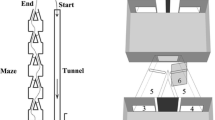Summary
Movement-induced visual orientation in flies depends largely upon predictable responses which establish simple “optomotor balance” or complex “pseudo search” in the appropriate visual environment. Less conspicuous course diverting spontaneous actions of the flies become important in pattern-induced visual orientation. The apparently stochastic spontaneous actions of the houseflyMusca domestica still allow powerful probabilistic predictions of orientation during stationary flight (Reichardt and Poggio 1981). The predominance of non-stochastic spontaneous actions such as “body saccades”, focussing and shift of “visual attention”, plasticity of response components etc. in the fruitflyDrosophila melanogaster (Heisenberg and Wolf 1979–1980) accounts for complementary behavioural options which reduce the relevance of probabilistic predictions of orientation in this fly.
The conjecture of “complementary options” is based on a striking antagonism between orientation towards a visual object (fixation), and orientation in the opposite direction (anti-fixation), in the walking fly. Forced choice in a multiple-Y-maze quite definitely elicits fixation in the wild type, and antifixation in the “optomotor blind” mutantomb H31 (Fig. 3). However, these effects cannot be attributed to a continuous predominance of attraction in the wild type and repellence in the mutant. This is shown under comparable conditions of free choice in an arena: The flies of either strain alternate between fixation and anti-fixation of an inaccessible visual object (Fig. 4a), and keep running to and fro between two of these objects in “Buridan's paradigm” (Fig. 4b, c), even if the objects are not alike (Fig. 4d). The sequence of approach, retreat and transition may be repeated a few thousand times to the point of exhaustion (Fig. 5). The process resembles the recurrent alternation of ambiguous figures such as the Necker cube in human perception. The recurrent transition between competitive objects counteracts the accumulation of spontaneous preferences, and is likely to explain the apparent lack of pattern-discrimination under operant and non-operant conditions of continued free choice inDrosophila. The conspicuous dichotomy of fixation and anti-fixation in the same environment is, as yet, incompatible with the phenomenological theory of visually controlled orientation in larger flies.
Similar content being viewed by others
Abbreviations
- S.E.M. :
-
standard error of the mean
References
Attneave F (1971) Multistability in perception. Sci Am 225(6):62–71
Blondeau J, Heisenberg M (1982) The 3-dimensional optomotor torque system ofDrosophila melanogaster. Studies on wild type and the mutant optomotor-blindH31. J Comp Physiol 145:321–329
Bülthoff H (1980) Orientation behaviour ofDrosophila melanogaster. Dissertation, Eberhard-Karls-Universität, Tübingen
Bülthoff H (1981) Figure-ground discrimination in the visual system ofDrosophila melanogaster. Biol Cybern 41:139–145
Bülthoff H (1982a)Drosophila mutants disturbed in visual orientation. I. Mutants affected in early visual processing. Biol Cybern 45:63–70
Bülthoff H (1982b)Drosophila mutants disturbed in visual orientation. II. Mutants affected in movement and position computation. Biol Cybern 45:71–77
Bülthoff H, Poggio T, Wehrhahn C (1980) 3-D analysis of the flight trajectories of flies (Drosophila melanogaster). Z Naturforsch [C] 35:811–815
Collett TS, Land MF (1975a) Visual control of flight behaviour in the hoverfly,Syritta pipiens L. J Comp Physiol 99:1–66
Collett TS, Land MF (1975b) Visual spatial memory in a hoverfly. J Comp Physiol 100:59–84
Fleischer A, Pflugradt M (1977) Continuous registration of X, Y-coordinates and angular position in behavioural experiments. Experientia 33:693–695
Götz KG (1971) Spontaneous preferences of visual objects inDrosophila. Drosophila Inform Serv 46:62
Götz KG (1975a) The optomotor equilibrium of theDrosophila navigation system. J Comp Physiol 99:187–210
Götz KG (1975b) Hirnforschung am Navigationssystem der Fliegen. Naturwissenschaften 62:468–475
Götz KG (1980) Visual guidance inDrosophila. In: Siddiqi O, Babu P, Hall LM, Hall JC (eds) Development and neurobiology ofDrosophila. Plenum, New York London Washington Boston, pp 391–407
Götz KG, Wenking H (1973) Visual control of locomotion in the walking fruitflyDrosophila. J Comp Physiol 85:235–266
Götz KG, Hengstenberg B, Biesinger R (1979) Optomotor control of wing beat and body posture inDrosophila. Biol Cybern 35:101–112
Hay DA (1975) Strain differences in maze-learning ability ofDrosophila melanogaster. Nature 257:44–46
Heisenberg M, Buchner E (1977) The role of retinula cell types in visual behavior ofDrosophia melanogaster. J Comp Physiol 117:127–162
Heisenberg M, Götz KG (1975) The use of mutations for the partial degradation of vision inDrosophila melanogaster. J Comp Physiol 98:217–241
Heisenberg M, Wolf R (1979) On the fine structure of yaw torque in visual flight orientation ofDrosophila melanogaster. J Comp Physiol 130:113–130
Heisenberg M, Wonneberger R, Wolf R (1978) OptomotorblindH31 — aDrosophila mutant of the lobula plate giant neurons. J Comp Physiol 124:287–296
Hirsch J (1959) Studies in experimental behavior genetics: II. Individual differences in geotaxis as a function of chromosome variations in synthesizedDrosophila populations. J Comp Physiol Psychol 52:304–308
Horn E (1978) The mechanism of object fixation and its relation to spontaneous pattern preferences inDrosophila melanogaster. Biol Cybern 31:145–158
Mimura K (1982) Discrimination of some visual patterns inDrosophila melanogaster. J Comp Physiol 146:229–233
Murphey RM (1965) Sequential alternation behavior in the fruit fly,Drosophila melanogaster. J Comp Physiol Psychol 60:196–199
Reichardt WE, Poggio T (1981) Visual control of flight in flies. In: Reichardt WE, Poggio T (eds) Theoretical approaches in neurobiology. MIT Press, Cambridge (Massachusetts), London, pp 135–150
Wehner R (1981) Spatial vision in Arthropods. In: Autrum H (ed) Comparative physiology and evolution of vision in invertebrates. Springer, Berlin Heidelberg New York (Handbook of sensory physiology, vol VII/6C, pp 288–616)
Wehner R, Horn E (1975) The effect of object distance on pattern preferences in the walking fly,Drosophila melanogaster. Experientia 31:641–643
Wolf R, Heisenberg M (1980) On the fine structure of yaw torque in visual flight orientation ofDrosophila melanogaster. II. A temporally and spatially variable weighting function for the visual field (“visual attention”). J Comp Physiol 140:69–80
Author information
Authors and Affiliations
Rights and permissions
About this article
Cite this article
Bülthoff, H., Götz, K.G. & Herre, M. Recurrent inversion of visual orientation in the walking fly,Drosophila melanogaster . J. Comp. Physiol. 148, 471–481 (1982). https://doi.org/10.1007/BF00619785
Accepted:
Issue Date:
DOI: https://doi.org/10.1007/BF00619785




